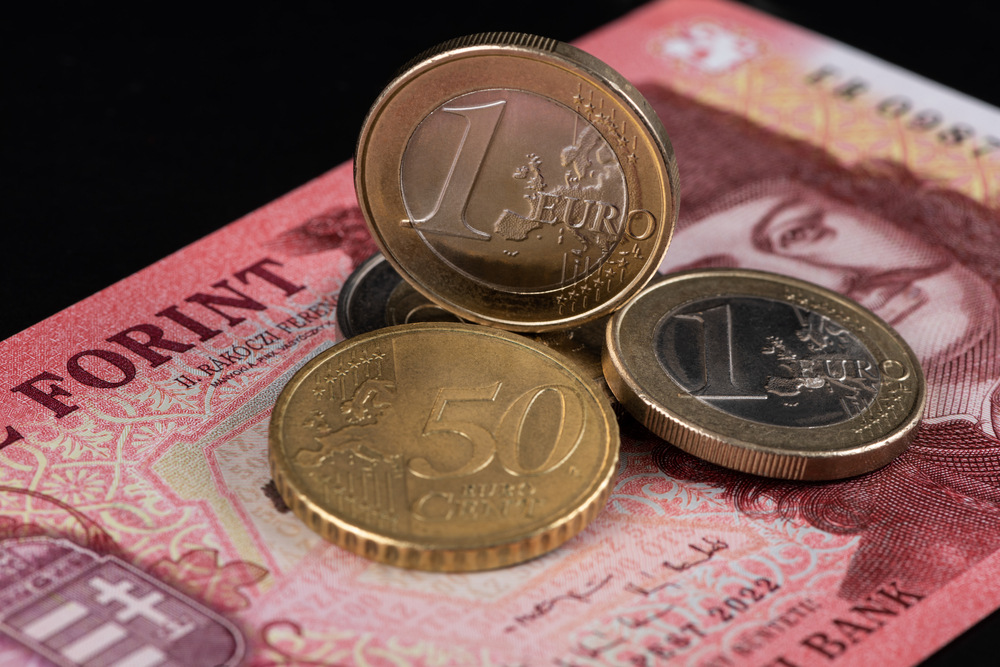Possible 400 EUR/HUF exchange rate amid Hungarian central bank decisions

Will we see a 400 EUR/HUF exchange rate again this year? The Hungarian National Bank (Magyar Nemzeti Bank, MNB) is anticipated to continue its trend of monetary easing with a 50 basis point interest rate cut at its meeting tomorrow. This would lower the benchmark rate to 7.25%. However, according to economists consulted by Portfolio, this aggressive easing phase is approaching its conclusion. Despite the central bank’s cautious stance, analysts predict that the euro could exceed the HUF 400 mark by the end of the year.
Barnabás Virág, the MNB Vice President, told Portfolio last week that the base rate could settle around 6.75-7% by mid-year. This view is shared by market participants, who expect an imminent 50 basis point cut followed by a similar reduction in June. This would align the base rate with the mid-year target of 6.75%.
The consensus is clear: an immediate 50 basis point cut is anticipated, with most expecting a similar decision in June, although a minority predicts a smaller, 25 basis point reduction. This pattern indicates a shift towards a more conservative approach as the year progresses.
Monetary Council might opt for a larger cut

András Pintér from Apelso Capital notes that the central bank has been signaling a cautious approach, preparing the market for smaller steps. The market’s expectations, particularly towards the year-end, have outpaced the central bank’s plans. Therefore, in May, the Monetary Council might opt for the larger 50 basis point cut, but June could see a continuation of this trend if necessary.
The inflation trends in the services sector might concern the central bank, yet recent international developments provide some leeway for this decision. Global risk appetite has stabilised following a brief “risk-off” period in April, which is also reflected in the HUF’s exchange rate. According to Pintér, the upcoming communications will likely emphasise the nearing end of the rate-cutting cycle.
Unicredit’s lead analyst, Zsolt Becsey, highlights that the easing of public friction between monetary and fiscal policies broadens the central bank’s manoeuvring space. This flexibility is further supported by recent weak US macroeconomic data, which have bolstered expectations for three Federal Reserve rate cuts this year, benefiting emerging markets like Hungary.
The past year has seen a dramatic reduction in the base rate, from 13% to 10.75% by the end of 2023, with a mid-year target of 6.75%. This rapid series of cuts might suggest a deeper reduction by year-end, but current forecasts do not support this. In fact, the consensus points to a significant slowdown, with a year-end forecast of 6.5%.
Erste Bank’s chief economist, Orsolya Nyeste, points out that several factors, including rising inflation and the need to maintain positive real interest rates, limit further cuts in the latter half of 2024. The policies of major and regional central banks, combined with domestic inflation and fiscal conditions, will heavily influence the MNB’s remaining scope for action, which appears to be minimal.
Surge in inflation, 400 EUR/HUF exchange rate expected this year

ING expert Péter Virovácz anticipates a significant inflation surge in the second half of the year, peaking at 5.5-6%. Consequently, the June rate cut might be the last in this cycle. The expected inflation rise, fiscal adjustments boosting inflation, and the monetary policies of regional central banks all suggest that the MNB will adopt a cautious and wait-and-see approach. Should internal and external conditions turn favourable, there might be room for an additional 50 basis points cut in total.
Péter Koncz from Századvég Gazdaságkutató emphasises the growing importance of imported inflation. This highlights the crucial role of exchange rate stability in maintaining price stability. However, despite these efforts, analysts seem sceptical about the HUF’s stability over the next year. The consensus forecast suggests that
the euro exchange rate will fluctuate between 383 and 409 HUF, with many predictions leaning towards breaching the 400 mark.
This indicates that the market believes that, despite the central bank’s cautious rate cuts, the regional yield convergence will not prevent the HUF’s weakening trajectory.
Therefore, even with the Hungarian National Bank’s measured approach to monetary easing, the euro is expected to surpass the 400 HUF threshold, reflecting broader market trends and economic conditions.
Read also:
- Surprising: German companies push for euro in Hungary – will PM Orbán introduce it?
- Expert: Quality of food in Hungarian shops often worse than in Western Europe
Featured image: depositphotos.com
Source:





